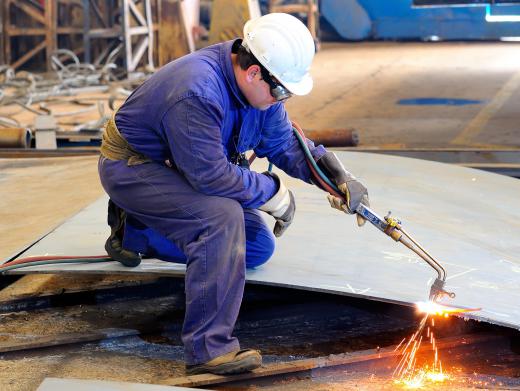An acetylene generator is a device which produces a steady supply of acetylene gas for use in welding works, repair, or construction shops where acetylene is constantly required. The device, which has two basic types, works by exposing calcium carbide to water which produces acetylene gas. it can be beneficial for businesses using large quantities of acetylene on a daily basis, as there are fewer potential supply interruptions, and the cost of the end product is lower. Installation, use, and maintenance of an acetylene generator are, however, subject to strict safety measures because acetylene is an extremely dangerous gas which readily explodes at a wide range of gas to air concentrations.
Acetylene is a highly flammable, colorless gas with a slight garlic odor used extensively in conjunction with oxygen for welding, brazing, and cutting of steel. It is also used in several other industrial applications including face hardening of large steel parts and radiocarbon dating. Oxy-acetylene welding and cutting is, however, the single largest consumer of acetylene accounting for approximately 20% of global consumption. It is typically in these applications where acetylene generators are used.

There are two basic types of acetylene generator; the first of which utilizes a hopper system to feed calcium carbide in granular or powdered form into tank of water. The second feeds water over a layer of carbide at the bottom of the generator. Both types of generators should be well sealed and equipped with pressure safety valves to safeguard against spikes in the internal pressure of the generated gas.
The latter method is the less desirable of the two processes as it generates considerable heat. It also tends to produce acetylene long after the water flow is stopped. This makes rapid cut-off of the process difficult. The carbide feed process, on the other hand, sees the carbide quenched in water during the generation of the acetylene which leads to lower temperatures and controllable cut-off of gas production.
The installation and use of an acetylene generator should always be carried out by qualified personal due to the ever present danger of explosion that surrounds the production and use of the gas. The acetylene generator should be housed well away from the area where the work is carried out, no lights or naked flames should be allowed near the generator, and the building should be steam heated. Care should be taken to ensure the highest levels of purity possible in the carbide supply as phosphate contamination is common in carbide and can cause the simultaneous production of hydrogen phosphide gas. This contaminant may have an adverse effect on the metals welded with oxy-acetylene systems. Special attention also needs to be paid to pressure control in an acetylene generator as the gas decomposes explosively at pressures exceeding 15 pounds per square inch (PSI).
